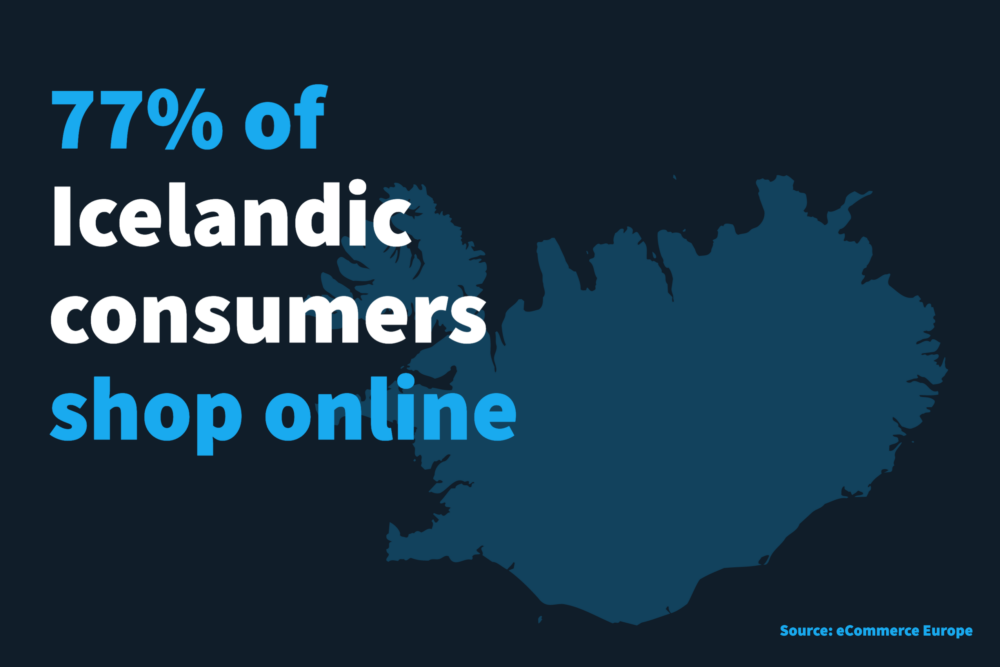Here Are The Top Icelandic Payment Methods Consumers are Using Now
This report covers 2021. Looking for the most recent data? Read our latest report.
Tourism is one of Iceland’s biggest industries, and it’s no surprise given the natural beauty of the small island nation. With just 344,000 residents, Iceland is a small but influential single market area (Worldometers).
Iceland’s most important industry is tourism, which is beginning to bounce back from the global COVID-19 pandemic. In fact, the total number of foreign overnight visitors to Iceland was just under half a million in 2020; in 2019, foreign visitors numbered around 2 million (The Icelandic Tourism Board).
Iceland’s tourism is expected to recover. Alongside that recovery is the expectation of a flourishing ecommerce industry. Iceland is dependent on imports, and there are no limits on selling products or services outside of EU compliance (U.S. Dept of Commerce).
Iceland’s globally-minded populace has a high internet usage, with online shopping growing in popularity. In fact, 77% of consumers shop online (Ecommerce Europe). B2B eCommerce in Iceland is also showing high growth potential. (U.S. Dept of Commerce). The biggest challenges for merchants doing business in Iceland are high shipping costs, 24% VAT added to all imported goods, and steep local postal service handling fees (U.S. Dept of Commerce).
Iceland is a lucrative and exciting market for both local businesses and global companies looking to expand. By understanding the top Iceland payment methods, merchants can get ready to expand into this Nordic country.
Fast Facts: eCommerce in Iceland
- In Iceland, the sales revenue of business-to-business (B2B) transactions of physical goods was estimated at 259 million U.S. dollars in 2019, an increase from the previous years. Continued growth is expected until at least 2024, when the revenue from B2B e-commerce sales is expected to reach 508 million U.S. dollars. (Statista)
- The monetary unit of Iceland is known as the Icelandic Króna (ISK). However, Icelanders use almost exclusively credit and debit cards as their top payment methods. (U.S. Dept of Commerce).
Icelandic Payment Methods – What Is The Most Popular?
Payment methods and preferences differ greatly from country to country. Here are the most popular Icelandic payment methods.
Cards
Many Icelanders live largely cash-free. Debit and credit cards are accepted just about everywhere, and for many locals, they are the preferred payment method in Iceland — even at one of Reykjavik’s most popular hot dog stands! (Rekjavik Auto). Cash is only 2.3% of Iceland’s GDP, and most of the country operates cash-free (European Payments Council).
Visa and Mastercard are widely accepted in Iceland. Iceland takes its national financial security very seriously after being hit hard by the 2008 financial crisis. (Bloomberg). These days, swipe-and-sign cards are out. Icelanders pay with chip-and-pin cards that are generally more secure – or they pay using a digital wallet.

Digital Wallets
Digital wallets are gaining traction as one of the most popular online payment methods in Iceland, especially since Icelanders are so keen to do their banking and buying from their smartphones. Today, Nordic fintechs are popping up to offer more locally-based solutions for payers.
According to Sveinbjorn Snorri Gretarsson, Executive Director of Payments at Islandsbanki (The Bank of Iceland), “tech thirsty” Icelanders routinely use ApplePay and also occasionally use fitness device based Garmin-Pay and Fitbit-Pay for contactless payments (European Payments Council).
Bank Transfers
For bank transfers, Iceland uses Single Euro Payments Area (SEPA). This works when the payer authorizes a creditor to obtain funds from the payer’s bank account. This lets customers pay for purchases through bank transfers, direct debit payments and card payments while denominated in Euros. SEPA covers all of the European Union as well as countries like Iceland, Switzerland, UK and others. SEPA helps make cross-border payments as simple as domestic payments (European Commission).
Iceland: A Rebounding Economy Poised for eCommerce Growth
As Iceland recovers from a major tourism blow during the global pandemic, the country’s ecommerce landscape is expected to ramp back up. This is thanks to a growing preference for online shopping, plus a familiarity with and desire for foreign imported goods. Because of that, payments for cross-border purchases will likely track upwards. The same goes for B2B payments in Iceland and from Iceland, internationally.
For you to succeed in the Icelandic market, you must accept consumers’ preferred payment methods while providing an easy checkout experience. The digital landscape is changing quickly, and companies must tailor their approach to the Nordic environment — especially in a culture where trust is integral. Merchants must support all of Iceland’s local payment methods in order to attract shoppers and keep buyers coming back.
Rapyd’s All-in-One Payments Solution in Iceland
Explore all the capabilities and payment methods Rapyd has available. With the ability to accept credit and debit cards, plus hundreds of local and alternative payment methods worldwide, Rapyd is the easiest way for businesses to reach more places and more customers.
- Don’t wait, start selling today
- Accept payments worldwide
- Fast, reliable customer service
Rapyd makes it easy to reach billions of customers by accepting cards and local payments worldwide.
SOURCES
Ecommerce Europe, 2019, https://www.ecommerce-europe.eu/wp-content/uploads/2019/07/European_Ecommerce_report_2019_freeFinal-version.pdf).
Bloomberg. “National Security Has Iceland Pushing for Domestic Payment Tool.” Bloomberg.com, 25 August 2021, https://www.bloomberg.com/news/articles/2021-08-25/national-security-has-iceland-pushing-for-domestic-payment-tool. Accessed 8 February 2022.
European Payments Council. “Country profile: cashless Iceland.” European Payments Council, 4 November 2020, https://www.europeanpaymentscouncil.eu/news-insights/insight/country-profile-cashless-iceland. Accessed 8 February 2022.
“Iceland – eCommerce.” International Trade Administration, 3 October 2021, https://www.trade.gov/country-commercial-guides/iceland-ecommerce. Accessed 8 February 2022.
The Icelandic Tourism Board. “Numbers of foreign visitors | Icelandic Tourist Board.” Ferðamálastofa, https://www.ferdamalastofa.is/en/recearch-and-statistics/numbers-of-foreign-visitors. Accessed 8 February 2022.
“Iceland Population (2022).” Worldometer, https://www.worldometers.info/world-population/iceland-population/. Accessed 8 February 2022.
Reykjavik Auto. “Debit and Credit Cards in Iceland: Essential Info.” Reykjavik Auto, 2019, https://www.reykjavikauto.com/blogs/debit-cards-credit-cards-iceland. Accessed 8 February 2022.
Statista. “• Iceland: B2B e-commerce revenue of physical goods 2024.” Statista, 11 June 2021, https://www.statista.com/statistics/1242259/b2b-e-commerce-revenue-of-physical-goods-iceland/. Accessed 8 February 2022.
European Commission. “Single euro payments area (SEPA) | European Commission.” European Commission, https://ec.europa.eu/info/business-economy-euro/banking-and-finance/consumer-finance-and-payments/payment-services/single-euro-payments-area-sepa_en. Accessed 10 February 2022.
Payment Wall. “Payment Methods in Iceland.” Paymentwall, https://www.paymentwall.com/en/payment-methods/iceland. Accessed 10 February 2022.
Subscribe Via Email
Thank You!
You’ve Been Subscribed.


